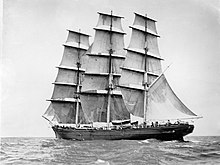
and the associated exhibition was breath-taking.
The Cutty Sark was built (in Scotland) to carry tea as quickly as possible from China to Britain:

(here's a photo of the Cutty Sark pretty much in full sail)
and during her voyages very nearly her whole hull was stacked solid with tea chests.
The trouble is, how do you know which particular sort of tea each tea chest contains? The chests were labelled in Chinese, but the some of the crew couldn't read English letters (the Cutty Sark was launched in 1869) let alone Chinese characters.
Well, they discovered that there was another way to read the tea chests. Each chest was beautified with a floral design:

(photo by Adèle Geras)
and the crew soon learned which configuration of red chrysanthemums or dreamy sky blue background represented which tea plantation.
But it turns out that these beautiful tea chest were used to communicate much more than their contents.
Once the chests were opened they were broken up and used for firewood about the docks, but the valuable lead strips that sealed the joins (you can see them in the photograph) would be scavenged by the crew and taken to Fleet Street, the home of the London newspaper industry, to be cast into lead to make type to print newspapers.
With pleasing symmetry, some of these newspapers would be reporting the record-breaking speeds of the tea clipper Cutty Sark during a life that saw her sail even further than to the moon and back.
Word To Use Today: tea. This word comes from the Amoy Chinese t'e, from the Ancient Chinese d'a.
No comments:
Post a Comment
All comments are very welcome, but please make them suitable for The Word Den's family audience.